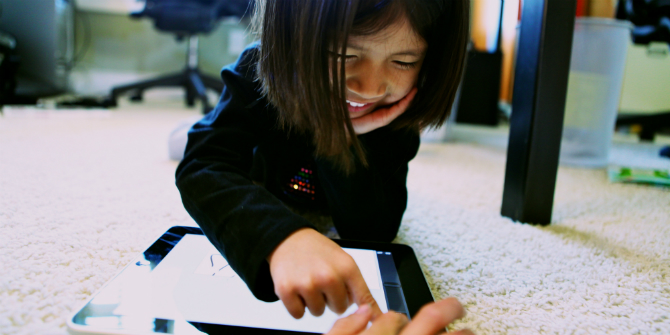Supporting and Developing Parents’ Strategies for Children’s Use of Digital Media at Home
April 21, 2017
PROJECTS: Preparing for a Digital Future
TAGS:
Natalia Kucirkova explores the inherent difficulties in balancing children’s media use and concludes that there is no magic formula for a balanced media diet. Natalia is a Senior Research Fellow at the University College London. She researches innovative ways of supporting children’s reading engagement with digital books and the role of personalisation in early years.

Image credit: M. Kwan, CC BY-SA 2.0
Children’s use of technology is often homogenised and described in generic terms of either ‘good’ or ‘bad’, but there are different and complex reasons why parents might not always achieve a balanced media diet for their children. In our study with Professor Karen Littleton and Dr Antonis Kyparissiadis, we were explicitly interested in understanding this variety, and our focus was on the challenge of achieving a balance between children’s digital and non-digital engagement at home.
The findings
The study drew on a nationally representative sample of 709 UK parents of children aged 0–8, who took part in a national survey carried out by the literacy charity Book Trust in 2015. The parents’ responses were analysed qualitatively and quantitatively to gauge their views and anxieties regarding children’s use of technology. We were particularly interested in which roles children’s age and gender play in parents’ views and attitudes. Parents of the youngest children (0–2) were especially worried about the health implications of digital media. For children aged 2 and above, the key challenge for parents was to balance their children’s engagement with non-digital alternatives. Parents often cited the media appeal and attention-grabbing features of technologies as a strong factor influencing their family dynamics. We also found that parents of boys were more concerned about the consequences of media use for their health than parents of girls. Parents of all children valued digital media in assisting their children to read and take part in educational activities, and family routines were mentioned as a key means to regulate children’s practices (e.g. TV only used before bedtime, iPad’s use limited to 20 minutes per day).
UK parents employ a variety of strategies, as Sonia Livingstone also argued in a recent piece on this blog. Some of these are guided by time restrictions, some by context and content, some by their own family routines and their child’s unique preferences, and some by a combination of all these factors.
Recommendations
We need to maintain openness and a degree of contextual sensitivity regarding children’s use of media at home and parents’ role in mediating it. Researchers, teachers and policy-makers must continue to develop strategies to support parents in raising their awareness of appropriate online content. We also need to look for ways to make the most of the complementary nature of digital and non-digital learning.
In this respect, it is essential that parents and professionals work together to understand the benefits and limitations of digital media for children’s learning. There are some emerging examples of such collaborations. For example, the National Literacy Trust launched ‘LiteracyApps’, an online guide that helps parents and teachers choose apps suitable for a specific skill, activity or reading task. A project between the Royal Society of Arts and Manchester Metropolitan University led to the production of a short video for parents interested in using digital books (e-books) with their young children. The DigiLitEY COST Action has several working groups dedicated to providing tips and advice to parents across Europe, and several resources can be accessed on their website.
In conclusion
There is no magic formula to balance children’s media use at home. We need to be mindful of the tension between guidelines versus prescriptions for parents in relation to their children’s media use, and the myriad of factors influencing these. It’s not just about who has access to what device, but also about what parents think is important for their child. Family culture and parents’ perceptions profoundly shape the strategies they employ to support their children’s actual technology use.
NOTE
This article originally appeared on lse.ac.uk. It has been re-posted with permission.

